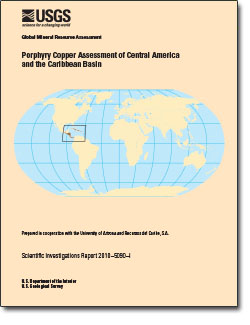 Abstract Abstract
Mineral resource assessments provide a synthesis of available information about distributions of mineral deposits in the Earth’s crust. The U.S. Geological Survey prepared a probabilistic mineral resource assessment of undiscovered resources in porphyry copper deposits in Central America and the Caribbean Basin in collaboration with geoscientists from academia and the minerals industry. The purpose of the study was to (1) delineate permissive areas (tracts) for undiscovered porphyry copper deposits within 1 kilometer of the surface at a scale of 1:1,000,000; (2) provide a database of known porphyry copper deposits and significant prospects; (3) estimate numbers of undiscovered deposits within the permissive tracts; and (4) provide probabilistic estimates of amounts of copper, molybdenum, gold, and silver that could be contained in undiscovered deposits. The assessment was done using a three-part mineral resource assessment based on established mineral deposit models. Permissive tracts were delineated based primarily on distributions of mapped igneous rocks related to magmatic arcs that formed in tectonic settings associated with convergent plate margins. Five permissive tracts were delineated: the Early Cretaceous through Eocene Santiago tract, the Late Cretaceous through Oligocene Chortis tract, the Paleocene through Oligocene Darién tract, the Miocene and Pliocene Cocos tract, and the Eocene to Holocene Lesser Antilles tract. These tracts range in size from about 3,000 to about 204,000 square kilometers.
Probabilistic estimates of numbers of undiscovered deposits were made for all tracts. To estimate the number of undiscovered porphyry copper deposits, data on known mineral deposits, prospects, and occurrences were considered along with mapped alteration zones, local stream-sediment geochemistry, exploration history, descriptive deposit models, and grade and tonnage models.
Most porphyry copper exploration in Central America and the Caribbean Basin has focused on Panama and on the exposed Cretaceous to Eocene central Cordilleran arc that extends from Cuba and Jamaica through Haiti and the Dominican Republic to Puerto Rico and the Virgin Islands. Interest in gold has prompted exploration of historical precious-metal prospects and small mines, some of which may represent high-sulfidation epithermal systems or skarns overlying, or adjacent to, porphyry copper systems.
This assessment estimated a total mean of 37 undiscovered porphyry copper deposits within the assessed permissive tracts in Central America and the Caribbean Basin. This represents more than five times the seven known deposits. Predicted mean (arithmetic) resources that could be associated with these undiscovered deposits are about 130 million metric tons of copper and about 5,200 metric tons of gold, as well as byproduct molybdenum and silver. The reported identified resources for the seven known deposits total about 39 million metric tons of copper and about 930 metric tons of gold. The assessment area is estimated to contain nearly four times as much copper and six times as much gold in undiscovered porphyry copper deposits as has been identified to date.
|
First posted February 28, 2014
Part or all of this report is presented in Portable Document Format (PDF). For best results viewing and printing PDF documents, it is recommended that you download the documents to your computer and open them with Adobe Reader. PDF documents opened from your browser may not display or print as intended. Download the latest version of Adobe Reader, free of charge.
|